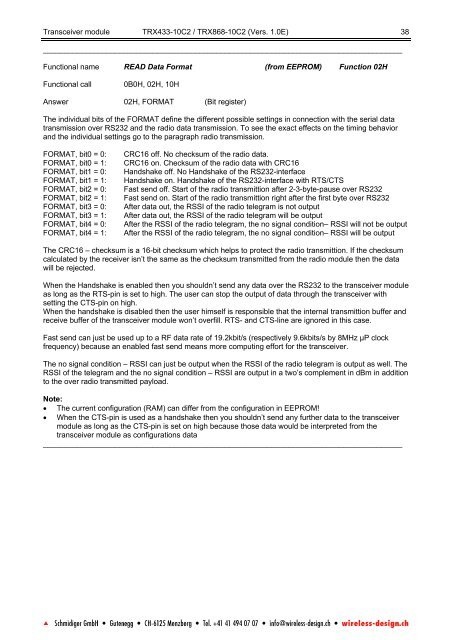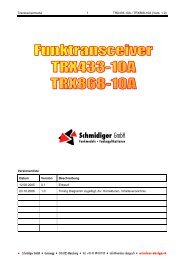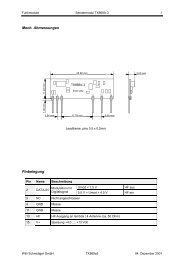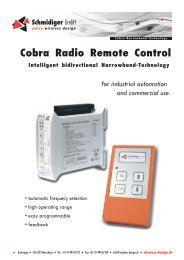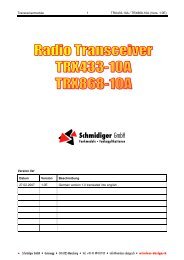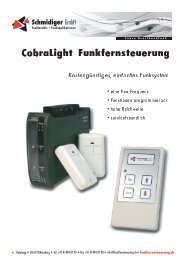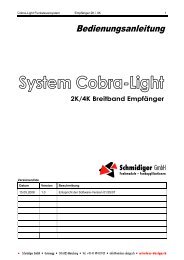Version List
Version List
Version List
Create successful ePaper yourself
Turn your PDF publications into a flip-book with our unique Google optimized e-Paper software.
Transceiver module TRX433-10C2 / TRX868-10C2 (Vers. 1.0E) 38<br />
_____________________________________________________________________________________<br />
Functional name READ Data Format (from EEPROM) Function 02H<br />
Functional call 0B0H, 02H, 10H<br />
Answer 02H, FORMAT (Bit register)<br />
The individual bits of the FORMAT define the different possible settings in connection with the serial data<br />
transmission over RS232 and the radio data transmission. To see the exact effects on the timing behavior<br />
and the individual settings go to the paragraph radio transmission.<br />
FORMAT, bit0 = 0: CRC16 off. No checksum of the radio data.<br />
FORMAT, bit0 = 1: CRC16 on. Checksum of the radio data with CRC16<br />
FORMAT, bit1 = 0: Handshake off. No Handshake of the RS232-interface<br />
FORMAT, bit1 = 1: Handshake on. Handshake of the RS232-interface with RTS/CTS<br />
FORMAT, bit2 = 0: Fast send off. Start of the radio transmittion after 2-3-byte-pause over RS232<br />
FORMAT, bit2 = 1: Fast send on. Start of the radio transmittion right after the first byte over RS232<br />
FORMAT, bit3 = 0: After data out, the RSSI of the radio telegram is not output<br />
FORMAT, bit3 = 1: After data out, the RSSI of the radio telegram will be output<br />
FORMAT, bit4 = 0: After the RSSI of the radio telegram, the no signal condition– RSSI will not be output<br />
FORMAT, bit4 = 1: After the RSSI of the radio telegram, the no signal condition– RSSI will be output<br />
The CRC16 – checksum is a 16-bit checksum which helps to protect the radio transmittion. If the checksum<br />
calculated by the receiver isn’t the same as the checksum transmitted from the radio module then the data<br />
will be rejected.<br />
When the Handshake is enabled then you shouldn’t send any data over the RS232 to the transceiver module<br />
as long as the RTS-pin is set to high. The user can stop the output of data through the transceiver with<br />
setting the CTS-pin on high.<br />
When the handshake is disabled then the user himself is responsible that the internal transmittion buffer and<br />
receive buffer of the transceiver module won’t overfill. RTS- and CTS-line are ignored in this case.<br />
Fast send can just be used up to a RF data rate of 19.2kbit/s (respectively 9.6kbits/s by 8MHz µP clock<br />
frequency) because an enabled fast send means more computing effort for the transceiver.<br />
The no signal condition – RSSI can just be output when the RSSI of the radio telegram is output as well. The<br />
RSSI of the telegram and the no signal condition – RSSI are output in a two’s complement in dBm in addition<br />
to the over radio transmitted payload.<br />
Note:<br />
• The current configuration (RAM) can differ from the configuration in EEPROM!<br />
• When the CTS-pin is used as a handshake then you shouldn’t send any further data to the transceiver<br />
module as long as the CTS-pin is set on high because those data would be interpreted from the<br />
transceiver module as configurations data<br />
_____________________________________________________________________________________


